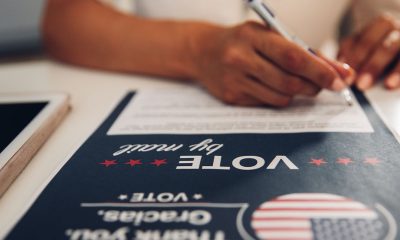Government
Supreme Court Hears Arguments on Maryland, North Carolina Redistrict Challenges
THE AFRO — For the second time in as many years, the Supreme Court heard arguments on partisan redistricting cases from Maryland and North Carolina Tuesday, but it remains unclear whether a constitutional standard for regulating the practice will be issued.
By Carolina Velloso
WASHINGTON – For the second time in as many years, the Supreme Court heard arguments on partisan redistricting cases from Maryland and North Carolina Tuesday, but it remains unclear whether a constitutional standard for regulating the practice will be issued.
North Carolina’s entire congressional map is being contested, which is currently made up of 10 Republicans and three Democrats despite the state being almost evenly split politically.
At issue in Maryland is the state’s 6th Congressional District. Democratic lawmakers are accused of moving Republican voters out of the district that covers most of the state’s rural Northwest and putting in large numbers of Democratic voters from the Washington suburbs in order to turn the district blue.
The justices seemed to be split evenly down philosophical lines, with the more liberal wing of the court encouraging the deliberation of a manageable standard to apply to future questions of gerrymandering, while the conservative wing seeming wary of intervening in a process left largely to the states.
The question, said Chief Justice John Roberts, is whether “any partisanship that has a consequence is impermissible.”
The conservative justices pointed out dozens of times that the Constitution does not require proportional representation — the idea that the percentage of seats awarded to any party should correspond with the percentage of votes it won in the states.
Michael A. Kimberly, attorney for the voters challenging Maryland’s 6th District, said that proportional consideration should be considered when debating a possible constitutional standard. He argued that “it is a legitimate state interest to pursue proportional representation in redistricting.”
Justice Samuel Alito wondered whether “the First Amendment might require or even tolerate the regulation of speech, and in this instance, the speech is the votes, for the purpose of providing a proportional representation of viewpoints.”
The justices repeatedly asked counsel for the appellees for a test that would appropriately determine which cases of gerrymandering were so extremely partisan that they crossed a constitutional line.
The conservative justices, however, did not seem to find a suitable measure that could determine when an innately political process became too political.
“Is another way…of putting the test: I know it when I see it?” Justice Neil Gorsuch asked derisively.
The court’s liberal justices pushed back, saying the problem of extreme partisan gerrymandering had gotten out of control and seemed willing to conceive of some sort of regulatory measure.
Justice Elena Kagan characterized “the court leaving this all to professional politicians who have an interest in redistricting according to their own partisan interests” as “dramatically wrong.”
Another concern expressed by the conservative justices was the possibility that the judicial branch would essentially become the arbiter of elections should the court get involved in setting a standard for redistricting.
The gerrymandering of Maryland’s 6th District, which was at issue in Lamone v. Benisek, was unique in that the map in question had been put to a referendum and was approved by 64 percent of voters.
Gorsuch still seemed hesitant to judicially intervene.
“So, in effect, you are asking the court, no matter how good the referendum might be, no matter how much the people themselves might approve these lines, this court has to tell them it — it’s unconstitutional?” Gorsuch asked counsel for the appellees.
Justice Stephen Breyer proposed a standard that would only catch the “extreme outliers,” so that not every single election would be judicially contested.
“What I’m trying to do is to figure out if there’s a way to catch real outliers,” he said, so that it would not “lead to every election contested and throw it all to the judges instead of the people.“
Breyer said he considers a scenario where a party wins a majority of the statewide vote but the minority party wins two-thirds of the state’s congressional seats to be “pretty extreme.”
Breyer thus proposed a mathematical standard whereby congressional election results would be re-examined if one party won a majority of the statewide vote but one-third or less of the congressional seats.
Steven M. Sullivan, the solicitor general of Maryland and representative of the appellant, seemed doubtful that a formula that would only catch extreme outliers for review is unrealistic.
“If you’re concerned about limiting the Court’s intervention to the extreme circumstance,” he said, “you would not be limiting it to extreme. You would be saying ‘get ready, Arkansas, Kansas, Massachusetts, Oklahoma, Alabama, Kentucky, Tennessee.’”
The court is expected to issue a decision on whether to keep the drawing of congressional district maps in the hands of the states by July.
This article originally appeared in The Afro.
Activism
Oakland Post: Week of December 24 – 30, 2025
The printed Weekly Edition of the Oakland Post: Week of – December 24 – 30, 2025

To enlarge your view of this issue, use the slider, magnifying glass icon or full page icon in the lower right corner of the browser window.
Alameda County
Oakland Council Expands Citywide Security Cameras Despite Major Opposition
In a 7-1 vote in favor of the contract, with only District 3 Councilmember Carroll Fife voting no, the Council agreed to maintain its existing network of 291 cameras and add 40 new “pan-tilt-zoom cameras.”

By Post Staff
The Oakland City Council this week approved a $2.25 million contract with Flock Safety for a mass surveillance network of hundreds of security cameras to track vehicles in the city.
In a 7-1 vote in favor of the contract, with only District 3 Councilmember Carroll Fife voting no, the Council agreed to maintain its existing network of 291 cameras and add 40 new “pan-tilt-zoom cameras.”
In recent weeks hundreds of local residents have spoken against the camera system, raising concerns that data will be shared with immigration authorities and other federal agencies at a time when mass surveillance is growing across the country with little regard for individual rights.
The Flock network, supported by the Oakland Police Department, has the backing of residents and councilmembers who see it as an important tool to protect public safety.
“This system makes the Department more efficient as it allows for information related to disruptive/violent criminal activities to be captured … and allows for precise and focused enforcement,” OPD wrote in its proposal to City Council.
According to OPD, police made 232 arrests using data from Flock cameras between July 2024 and November of this year.
Based on the data, police say they recovered 68 guns, and utilizing the countywide system, they have found 1,100 stolen vehicles.
However, Flock’s cameras cast a wide net. The company’s cameras in Oakland last month captured license plate numbers and other information from about 1.4 million vehicles.
Speaking at Tuesday’s Council meeting, Fife was critical of her colleagues for signing a contract with a company that has been in the national spotlight for sharing data with federal agencies.
Flock’s cameras – which are automated license plate readers – have been used in tracking people who have had abortions, monitoring protesters, and aiding in deportation roundups.
“I don’t know how we get up and have several press conferences talking about how we are supportive of a sanctuary city status but then use a vendor that has been shown to have a direct relationship with (the U.S.) Border Control,” she said. “It doesn’t make sense to me.”
Several councilmembers who voted in favor of the contract said they supported the deal as long as some safeguards were written into the Council’s resolution.
“We’re not aiming for perfection,” said District 1 Councilmember Zac Unger. “This is not Orwellian facial recognition technology — that’s prohibited in Oakland. The road forward here is to add as many amendments as we can.”
Amendments passed by the Council prohibit OPD from sharing camera data with any other agencies for the purpose of “criminalizing reproductive or gender affirming healthcare” or for federal immigration enforcement. California state law also prohibits the sharing of license plate reader data with the federal government, and because Oakland’s sanctuary city status, OPD is not allowed to cooperate with immigration authorities.
A former member of Oakland’s Privacy Advisory Commission has sued OPD, alleging that it has violated its own rules around data sharing.
So far, OPD has shared Flock data with 50 other law enforcement agencies.
Activism
Families Across the U.S. Are Facing an ‘Affordability Crisis,’ Says United Way Bay Area
United Way’s Real Cost Measure data reveals that 27% of Bay Area households – more than 1 in 4 families – cannot afford essentials such as food, housing, childcare, transportation, and healthcare. A family of four needs $136,872 annually to cover these basic necessities, while two adults working full time at minimum wage earn only $69,326.

By Post Staff
A national poll released this week by Marist shows that 61% of Americans say the economy is not working well for them, while 70% report that their local area is not affordable. This marks the highest share of respondents expressing concern since the question was first asked in 2011.
According to United Way Bay Area (UWBA), the data underscores a growing reality in the region: more than 600,000 Bay Area households are working hard yet still cannot afford their basic needs.
Nationally, the Marist Poll found that rising prices are the top economic concern for 45% of Americans, followed by housing costs at 18%. In the Bay Area, however, that equation is reversed. Housing costs are the dominant driver of the affordability crisis.
United Way’s Real Cost Measure data reveals that 27% of Bay Area households – more than 1 in 4 families – cannot afford essentials such as food, housing, childcare, transportation, and healthcare. A family of four needs $136,872 annually to cover these basic necessities, while two adults working full time at minimum wage earn only $69,326.
“The national numbers confirm what we’re seeing every day through our 211 helpline and in communities across the region,” said Keisha Browder, CEO of United Way Bay Area. “People are working hard, but their paychecks simply aren’t keeping pace with the cost of living. This isn’t about individual failure; it’s about policy choices that leave too many of our neighbors one missed paycheck away from crisis.”
The Bay Area’s affordability crisis is particularly defined by extreme housing costs:
- Housing remains the No. 1 reason residents call UWBA’s 211 helpline, accounting for 49% of calls this year.
- Nearly 4 in 10 Bay Area households (35%) spend at least 30% of their income on housing, a level widely considered financially dangerous.
- Forty percent of households with children under age 6 fall below the Real Cost Measure.
- The impact is disproportionate: 49% of Latino households and 41% of Black households struggle to meet basic needs, compared to 15% of white households.
At the national level, the issue of affordability has also become a political flashpoint. In late 2025, President Donald Trump has increasingly referred to “affordability” as a “Democrat hoax” or “con job.” While he previously described himself as the “affordability president,” his recent messaging frames the term as a political tactic used by Democrats to assign blame for high prices.
The president has defended his administration by pointing to predecessors and asserting that prices are declining. However, many Americans remain unconvinced. The Marist Poll shows that 57% of respondents disapprove of Trump’s handling of the economy, while just 36% approve – his lowest approval rating on the issue across both terms in office.
-

 #NNPA BlackPress4 weeks ago
#NNPA BlackPress4 weeks agoLIHEAP Funds Released After Weeks of Delay as States and the District Rush to Protect Households from the Cold
-

 Alameda County4 weeks ago
Alameda County4 weeks agoSeth Curry Makes Impressive Debut with the Golden State Warriors
-

 #NNPA BlackPress4 weeks ago
#NNPA BlackPress4 weeks agoSeven Steps to Help Your Child Build Meaningful Connections
-

 #NNPA BlackPress4 weeks ago
#NNPA BlackPress4 weeks agoSeven Steps to Help Your Child Build Meaningful Connections
-

 #NNPA BlackPress4 weeks ago
#NNPA BlackPress4 weeks agoTrinidad and Tobago – Prime Minister Confirms U.S. Marines Working on Tobago Radar System
-

 #NNPA BlackPress4 weeks ago
#NNPA BlackPress4 weeks agoThanksgiving Celebrated Across the Tri-State
-

 #NNPA BlackPress4 weeks ago
#NNPA BlackPress4 weeks agoTeens Reject Today’s News as Trump Intensifies His Assault on the Press
-

 #NNPA BlackPress4 weeks ago
#NNPA BlackPress4 weeks agoBreaking the Silence: Black Veterans Speak Out on PTSD and the Path to Recovery






















































